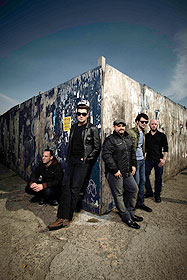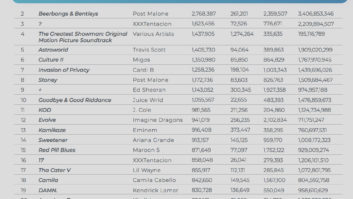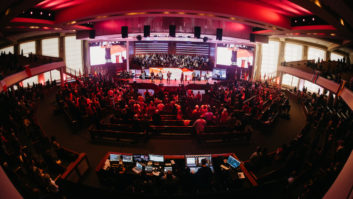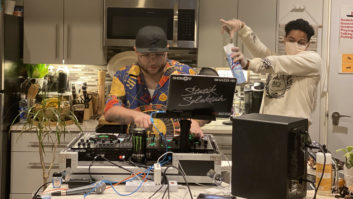
Taking Back Sunday is, from left: Mark O’Connell, Adam Lazzara, Eddie Reyes, John Nolan and Shaun Cooper
Photo: Phillip Graybill
Released in late June, Taking Back Sunday’s self-titled fifth studio album marks the return of the band’s original lineup from their 2002 debut, Tell All Your Friends. Vocalist Adam Lazzara, guitarist Eddie Reyes and drummer Mark O’Connell reunited with vocalist/guitarist John Nolan and bassist Shaun Cooper, who departed the band in 2003. And from the way Nolan recalls their reunion, it was all O’Connell’s idea. “As things were winding down for Taking Back Sunday and their last album cycle,” Nolan says, “he started talking to Eddie and Adam about this idea [of reuniting the band] and then got in contact with Sean and I. Everyone was pretty skeptical about it at first—of whether or not this was going to work—but everyone was open and we started reconnecting and talking again, and then little by little, it led to us getting back together again.”
That sense of openness pervades the making of this album, beginning with settling down at Sonic Ranch Studio (El Paso, Texas) and enjoying its remote location to sit down in a room together, rekindle those musician friendships and, once everything began to mesh together, begin to write songs. Nolan says during that week, they wrote about 10 or 11 songs. The group reconvened a short while later at Sonic Ranch for another two weeks of writing and then flew up to Robert Lang Studio (Seattle), where they met with producer Eric Valentine; Valentine had worked with the band (sans Nolan and Cooper) on Louder Now (2006). With a slew of songs—almost 30 in all—in hand, Taking Back Sunday looked to Valentine to help refine the songs and take them to a new level. At that point, they started production work in earnest at Valentine’s Barefoot Studios in L.A.
“I wanted this record to be more simple,” Valentine says. “I wanted to focus more on the compositions themselves and less on dressing them up. The band worked very hard on the collection of songs for the record. I think it is one of the strongest collections of songs that the band has come up with. The band was very determined to be sure every part of every song earned its spot on the record.”
Nolan agrees: “We wanted to have an album full of really solid, well-written rock songs. That was our starting point. But at the same time, the goal became to let each song take whatever shape or direction it needed to make it the strongest it could be. There was a lot of trying to stay open as the song developed; let each song become its own experience.”

At Barefoot, Valentine worked on his newly installed custom Undertone Audio console; this is the first album that was recorded on the new board and Valentine says it was “a great opportunity to put it through its paces.” He recorded to Pro Tools and then transferred to analog for the mix, printing to ½-inch. “I took a little more time than usual so I could experiment with the console and see what I could pull out of it,” Valentine adds. “I was tinkering with bits of the circuitry in the console and was able to make some refinements through the process. I have a feeling the tinkering will probably never stop.”
For the tracking, the band would play together as one, and then individual bandmembers would go back and fix parts later as needed. As for miking instruments, “On guitar,” Valentine says, “I have been using a mic-positioning robot that I control from the control room. I can sit in the sweet spot between my [Yamaha] NS-10s and dial in the position of the close mic on the speaker cab. I also recorded almost all of the lead vocals with two mics: a close mic, usually an SM7, and a room mic, an M49. The room mic was printed with a lot of compression. I could then blend the two differently for different sections of the song. With two lead singers, it’s sometimes important to be able to put them in different spaces. So with the room mic, I could make one of them sound farther away with real room acoustics when one singer was playing a supporting role to the other.”
The process took about three months of recording, with the majority of time spent honing each song and letting it shape into what it needed to become, both from the band and Valentine’s perspectives. “I’ve never worked with a producer that’s brought so much to the process,” Nolan says. “I really couldn’t believe what a difference he made in what we did. I feel that he could listen to a song and immediately know where it needs to go to improve. And he’s got a great way of taking his vision where he sees the song going and working completely with an open mind as to where we saw it going. It ended up being this really collaborative thought process.”

John Nolan tracking guitar with Eric Valentine
More With Taking Back Sunday’s John Nolan

Nolan on the vibe at Sonic Ranch Studio…
There’s a bunch of studios on the pecan farm and we had this one that was even more remote and separated from everything than some of the other studios. Across from the studio we had a house setup for us. It was very remote, very quiet, very peaceful and it was beautiful. We just hung out there and it was a combination of hang out and get to know each other again and work on music.
Nolan on a certain sound for each song…
With each song that we recorded, [Eric Valentine] would go through a bunch of different guitar and amp combinations with us before he settled on one, so we would be there trying these things out and he’s listening and making changes. We would have some input into how we were feeling each song as we were making those choices. A lot of the lead parts that I was playing, I was really interested in getting a classic fuzz sound, and a lot of times that would be layered in with a bunch of other guitar sounds. I always like a more vintage-y guitar sound with a distortion a bit more, natural gain and overdrive, ’60s and ’70s amps.
Nolan on the album’s overall sound…
The place where we started was that we wanted to have an album full of really solid, well-written rock songs. But at the same time, the goal became to let each song take whatever shape and whatever direction to make it the strongest. So there was a lot of trying to stay open as the song developed. In a certain way, there was maybe a lack of a goal that we would let each song take its shape. Not confine into one particular sound or style. Let each song become its own experience.
Watch a video tour of Taking Back Sunday inside Valentine’s studio:
Watch a video of tracking “You Could Play Harder (That’s What She Said)”
Assistant engineer Cian Riordan’s “Rockumentary”







